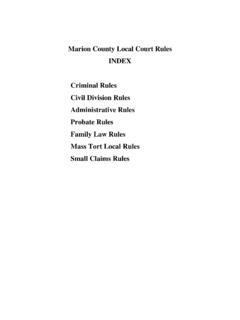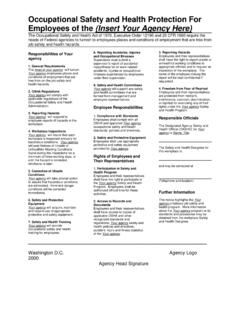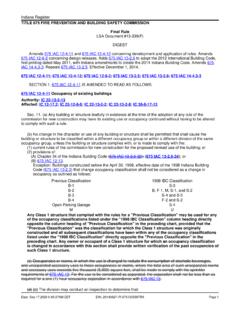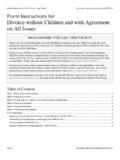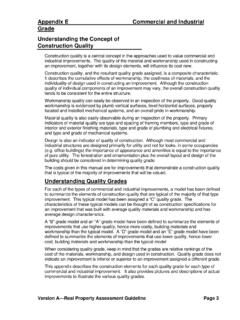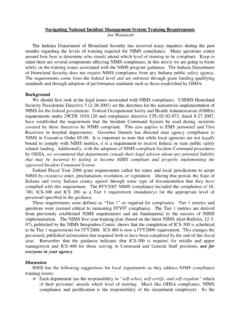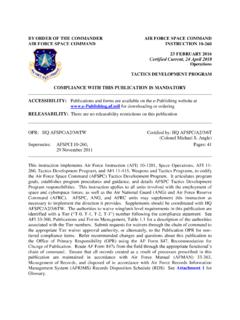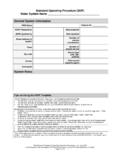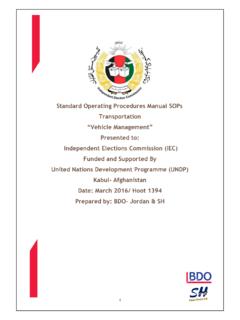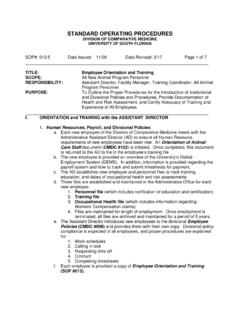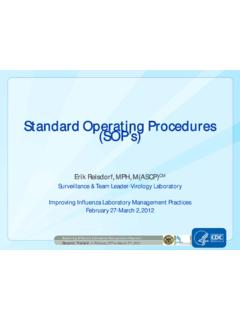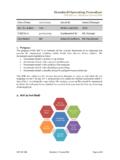Transcription of Standard Operating Procedures For
1 Standard Operating ProceduresFor INCIDENT COMMANDERSINCIDENT COMMANDERSFIRE HAZ-MAT EMERGENCY OPERATIONSU nder the National Incident Management System (NIMS). Developed by the DHS/SFM Emergency Response Division. COMMAND Standard Operating Procedures FOR FIRE & HAZARDOUS MATERIALS EMERGENCY OPERATIONS INDEX SECTION PAGE Introduction _____ 1 Purpose and Scope _____ 1 Command Overview _____ 1 Command Procedures _____ 3 Responsibilities of Command _____ 3 Functions of Command _____ 3 Establishing Command _____ 4 Radio Designation _____ 5 Brief Progress Report _____ 5 Command Options _____ 6 Transfer of Command _____ 8 Rules of Engagement _____ 10 Staging _____ 11 General Information _____ 13 Benchmarks _____ 14 Command Staff _____ 16 Command Structure Overview_____ 17 Incident Types Based of Five Levels of Complexity___ 17 Basic Organization _____ 19 Groups, Basic Operational Approach _____ 20 Expanding the Organization; Branch Officers _____ 23 Expansion to Major Operations (Unified Cmd) _____ 25 Command Staff Positions _____ 28 General Staff Positions _____ 31 Logistics Section _____ 31 Planning Section _____ 31 The Planning Process _____ 33 Operations Section _____ 39 Finance/Admin Section _____ 42 Information & Intelligence Section _____ 43 Area Command _____ 45 Emergency Operations Center _____ 46 Multi-Agency Coordination Entities _____ 46 Incident Management for Hazardous Materials Incidents ____ 47 NIMS Glossary of Key Terms _____ 57 COMMAND Standard Operating Procedures FOR FIRE & HAZARDOUS MATERIALS EMERGENCY OPERATIONS INTRODUCTION: The application of sound management principles to any undertaking that requires the coordination of various resources is paramount to the success of that undertaking.
2 This concept is applied to our personal and professional lives every day. We manage our personal budgets, our own time, and many other aspects of our own lives. Professionally we also manage our manpower and apparatus, the activities of our working days, our budget, and our goals and objectives. We do this by applying the basic textbook management principles of planning, directing, organizing, coordinating, communicating, delegating, and evaluating. So should it be with emergency operations. The major difference between routine, day-to-day management and emergency management is the timeframes for gaining control of the situation. Emergency operations still require the management of resources, goals and objectives, and activities in order to ensure a satisfactory outcome. In other words, emergency operations still require planning, directing, organizing, coordinating, communicating, delegating, and evaluating. Therefore, the same management process applied to our routine everyday operations can, and should, be applied to emergency operations.
3 This Standard Operating procedure clearly spells out the incident scene management process. It adopts the management principles previously mentioned and, because of its modular concept, it can be applied to any incident regardless of the type or magnitude of that incident. As a function-specific tool rather than a rank-specific one, it is equally adaptable because anyone can fill any position assuming appropriate training for that position. It shall be a matter of department policy that all personnel are familiar with this Standard Operating procedure and fully functional in any position which he/she might reasonably be expected to fill. PURPOSE AND SCOPE: The _____ responds to a wide range of emergency incidents. In order to effectively manage personnel and resources and to provide for the safety and welfare of personnel, we will always operate within the Incident Command System at the incident scene. This procedure identifies the Standard Operating Procedures to be employed in establishing Command and all the components of the Incident Command System (ICS).
4 The Command SOP is designed to meet or exceed the requirements of the National Incident Management System as outlined in _____ County Ordinance _____. COMMAND OVERVIEW: Incident Commanders have the authority and flexibility to modify Procedures and organizational structure as necessary to align with the Operating Command Procedures SOP 1 Effective Date: 1 October 2006 Revision Mandatory Review Date: 1 Jan 2007 characteristics of their specific jurisdiction or to accomplish the mission in the context of a particular hazard scenario. The incident commander should always integrate fire fighter and other emergency responder s health and safety considerations into the command process. This integration ensures that safety will always be considered and will not be reserved for unusual or high-risk situations when the incident commander is under a high degree of stress. An incident action plan that addresses responder safety should be a routine function of command. Early evaluation enables the incident commander to consider current conditions in a Standard manner and then predict the sequence of events that will follow.
5 The consideration of responder safety should be incorporated into this evaluation and forecasting. Effective communications are essential to ensure that the incident commander is able to receive and transmit information, obtain reports to maintain an awareness of the situation, and communicate with all component parts of the incident organization to provide effective supervision and controls. Strategic decisions establish the basic positioning of resources and the types of functions they will be assigned to perform at the scene of a fire or emergency incident. The level of risk to which members are exposed is driven by the strategy; offensive strategy places members in interior positions where they are likely to have direct contact with the fire or hazard, while defensive strategy removes members from interior positions and high-risk activities. The incident action plan is based on the overall strategy and drives the tactical assignments that are given to individual or groups of companies/crews and the specific functions they are expected to perform.
6 Risk identification, evaluation, and management concepts should be incorporated into each stage of the command process. Tactical-level management component people are command agents and are able to both monitor companies/crews at the actual location where the work is being done (geographic) and to provide the necessary support (functional). The incident commander uses a tactical-level management unit as off-site (from the command post) operational/communications/safety managers-supervisors. The incident commander uses the incident organization along with communications to stay connected. As incidents escalate, the incident management system should be utilized to maintain an effective span of control ratio of 3-to-7. The incident commander should routinely evaluate and re-evaluate conditions and reports of progress or lack of progress in reaching objectives. This process will allow the incident commander to determine if the strategy and attack plans should be continued or revised.
7 The failure to revise an inappropriate or outdated attack plan is likely to result in an elevated risk of death or injury to emergency responders. Effective command and control should be maintained from the beginning to the end of operations, particularly if command is transferred. Any lapse in the continuity of command and the transfer of information increases the risk to emergency responders. Command Procedures SOP 2 Effective Date: 1 October 2006 Revision Mandatory Review Date: 1 Jan 2007 The following Procedures further expand on this overview. All personnel shall review the entire Procedures and must demonstrate proficiency and competence before commanding an operation. COMMAND Procedures : Fix the responsibility for Command on a certain individual through a Standard identification system, depending on the arrival sequence of members, companies, and Command officers. Ensure that a strong, direct, and visible Command will be established from the onset of the incident.
8 Establish an effective incident organization defining the activities and responsibilities assigned to the incident commander and the other individuals Operating within the Incident Command System. Establish measurable objectives to ensure fulfillments of incident management goals. Provide a system to process information to support incident management, planning, and decision making. Provide a system for the orderly transfer of Command to subsequent arriving officers. RESPONSIBILITIES OF COMMAND: The Incident Commander is responsible for the completion of the tactical objectives. The tactical objectives (listed in order of priority) are: Remove endangered occupants and treat the injured. Stabilize the incident and provide for life safety. Conserve property Provide for the safety, accountability, and welfare of personnel. This priority is on-going throughout the incident. The Incident Command System is used to develop strategic objectives and to facilitate the completion of the tactical objectives.
9 The incident commander is the person who drives the Command system towards that end. The incident commander is responsible for building a Command structure that matches the organizational needs of the incident to achieve the completion of the tactical objectives for the incident. The function of Command defines Standard activities that are performed by the incident commander to achieve the tactical objectives. FUNCTIONS OF COMMAND: The functions of Command include: Assume and announce Command and establish an effective Operating position Command Post. Rapidly evaluate the situation (size-up) Initiate, maintain, and control the communications process. Command Procedures SOP 3 Effective Date: 1 October 2006 Revision Mandatory Review Date: 1 Jan 2007 Identify the overall strategy, develop an incident management plan, and assign units and personnel consistent with plans and Standard Operating Procedures . Develop an effective Incident Command organization. Develop Incident Action Plan (IAP).
10 Ensure safety of on-scene personnel. Review, evaluate, and revise (as needed) the Incident Management plan. Authorize release of information to all media operations. Coordinate activities of outside agencies. Provide for the continuity, transfer, and termination of Command. The incident commander is responsible for all of these functions. As Command is transferred, so is the responsibility for these functions. The first five (5) functions must be addressed immediately from the initial assumption of Command. ESTABLISHING COMMAND: The first fire department member or unit to arrive at the scene of a multiple unit response shall assume Command of the incident. The initial incident commander shall remain in Command until Command is transferred or the incident is stabilized and Command is terminated. One or two company (unit) responses that are not going to escalate beyond the commitment of these companies do not require a formal activation of the Incident Command System (as on-scene report with the assumption of Command).

